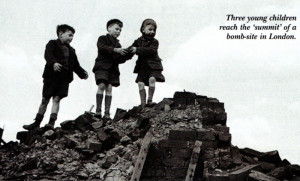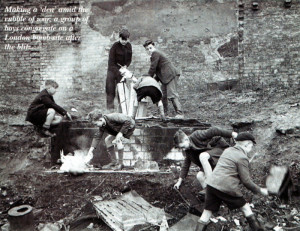
Seeing the film Hope and Glory on video recently reminded me of my own early youth in the early 1950s, camping out on bomb sites around my home in Rodney Road, Walworth, London SE17.
We had ourselves fallen victim of the air raids on London Docks, a whole row of houses in Thurlow Street, where we lived, being gutted by fire bombs one night in July 1943. Fortunately my mum and I, six months old, were sheltering in Kennington Underground station at the time. As a lot of families were evacuated from London it didn’t take us long to find alternative rented accommodation nearby. Most housing was rented in those days. Yates were the main commissioned agents – they still rent properties and have an office in Walworth Road.
My dad, who was serving in the Royal Navy, would pay us occasional visits when stationed at Chatham towards the end of the war. Each time he came home he noticed the absence of familiar landmarks. He never knew w hat to expect.
In time the bomb sites became our happy hunting ground, to which we escaped from reality. We saw no danger in playing in the derelict houses and exploring with morbid curiosity the after-effects of the bomb blasts – w’hole cross-sections of buildings opened up to the elements like model dolls’ houses.

Eventually the dangerous structures were demolished and we were left with the debris to sift through for our treasures – an assortment of bricks, wooden window frames and doors, old buckets, lead piping and an abundance of shattered glass.
From this assortment we made precarious structures for our camps, It was great fun constructing these mini-shelters and furnishing them as best we could from our homes. It was dirty and dangerous work, and we defied our parents as we met at our camps after school.
I remember digging up tarry blocks from Hillary Road, before it was macadamised. As well as burning them on the open fire (you had to watch out for the spitting impurities!) they were useful as supports for the covering on our camps. Anything that would protect us from the wind and rain w’as used. Improvements wTere made with the help of budding engineers, but often w’hen we got home from school, much to our disappointment we’d find the camps destroyed by rival gangs, who would remove the best materials for their own use. Over the years, springing up among the debris were dandelion and burdock and a variety of wild vegetation that was not readily appreciated by us at the time. We thought they were all weeds!
With amazing foresight, as there weren’t many privately-owned vehicles in those days, most of the large sites were cleared and purchased by National Car Parks. Many years later they were subsequendy sold off for valuable building land. A few sites remain, which have been converted into adventure playgrounds, so now our grandchildren play on the same ground as we did!
D. Shotifield








